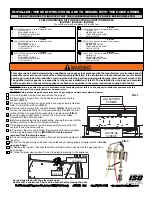
17
Jøtul C
550
CB Rockland 139656_02 10/2/14
Blower Operation
Access the blower control panel by lifting the cast
iron lower grille up off the insert.
The dual blowers will enhance heat circulation
around the firebox and out into the room. In the
Automatic
setting, the blowers are controlled by a
heat activated switch (snapstat) that will only func-
tion when the speed control is ON. After the fire has
been burning for a time, the snapstat will react to
the heat and activate the blowers. Conversely, the
blower will continue to operate until the snapstat
cools as the fire wanes. The blowers will then shut
off automatically.
The
Manual
setting overrides the snapstat
functionality allowing blower operation regardless
of temperatures.
For best performance, do not turn the switch on
until after the fire is well-established.
If the blower is not needed, place the blower
control switch in the OFF position.
See
Blower Maintenance,
page 19 for further
information.
Figure 18. C 550 CB Wiring diagram.
Color Key
BR - Brown
BL - Blue
BK - Black
GY - Gray
G - Green
Figure 17. Blower and speed controls.
It is also important to remember that chimney size,
temperature and height all affect draft which in turn
affects the formation of creosote. An exterior chimney,
whether masonry or prefabricated steel, will be ex-
posed to cold outside temperatures, and consequently,
will be more prone to creosote accumulation than an
interior flue.
A chimney flue located within the home interior
will benefit from the insulating characteristics of the
building itself. Consequently, the flue system will be
less conducive to condensation of unburned gases and
minimal creosote accumulation will result.
As a general rule, try to avoid burning the insert at
the lowest air control settings. Although a low setting
will prolong burn time, it may also result in incom-
plete combustion. In reducing the fire intensity, draft
is weakened and the chimney flue cools. This, together
with the increase in unburned gases, leads to rapid
creosote accumulation.
THIS BLOWER MUST BE ELECTRI-
CALLY GROUNDED IN ACCOR-
DANCE WITH LOCAL CODES OR, IN
THE ABSENCE OF LOCAL CODES,
WITH THE CURRENT ANSI/NFPA
70, NATIONAL ELECTRICAL CODE
OR CSA C22.1-CANADIAN ELECTRI-
CAL CODE.
THIS UNIT IS SUPPLIED WITH
A THREE-PRONG (GROUNDING)
PLUG FOR PROTECTION AGAINST
SHOCK HAZARD AND SHOULD BE
PLUGGED DIRECTLY INTO A PROP-
ERLY GROUNDED THREE-PRONG
RECEPTACLE. DO NOT CUT OR
REMOVE THE GROUNDING PRONG
FROM THE PLUG.
DO NOT USE ANY POWER SUPPLY
CORD OTHER THAN THAT SUP-
PLIED WITH THIS UNIT.
ALWAYS DISCONNECT THE POW-
ER SUPPLY WHEN PERFORMING
ANY SERVICE ON THE FIREPLACE
INSERT.
WARNING !












































